Finland E Commerce Market Size
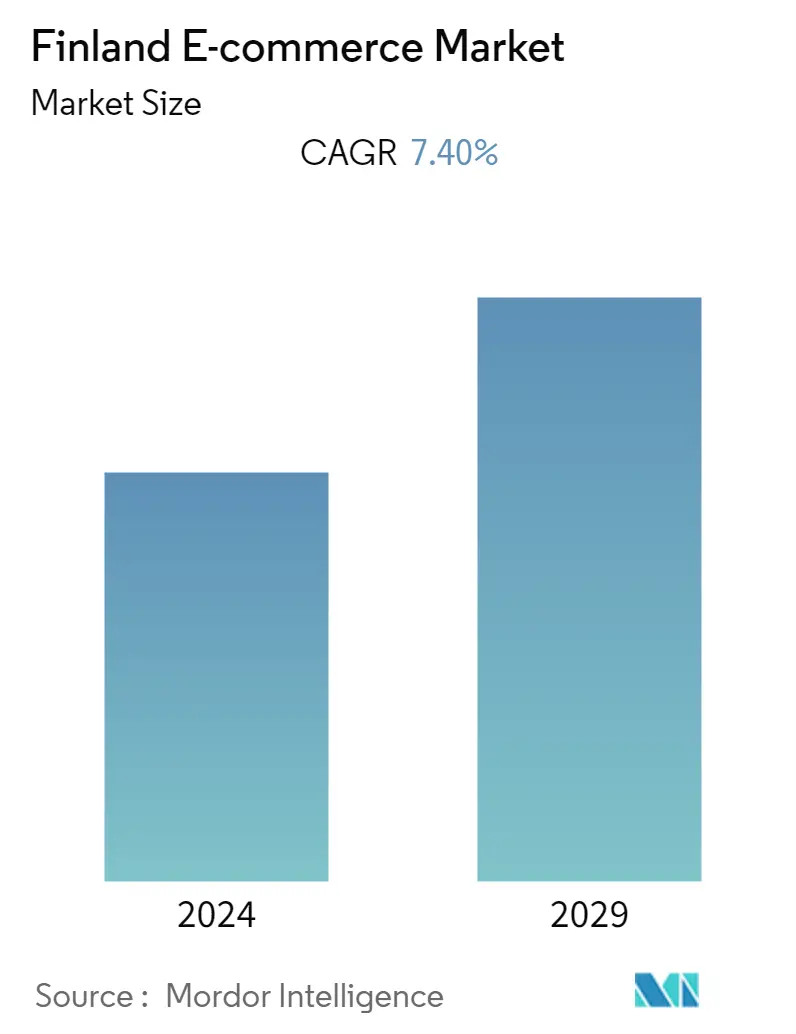
| Study Period | 2019 - 2029 |
| Base Year For Estimation | 2023 |
| Forecast Data Period | 2024 - 2029 |
| Historical Data Period | 2019 - 2022 |
| CAGR | 7.40 % |
| Market Concentration | Low |
Major Players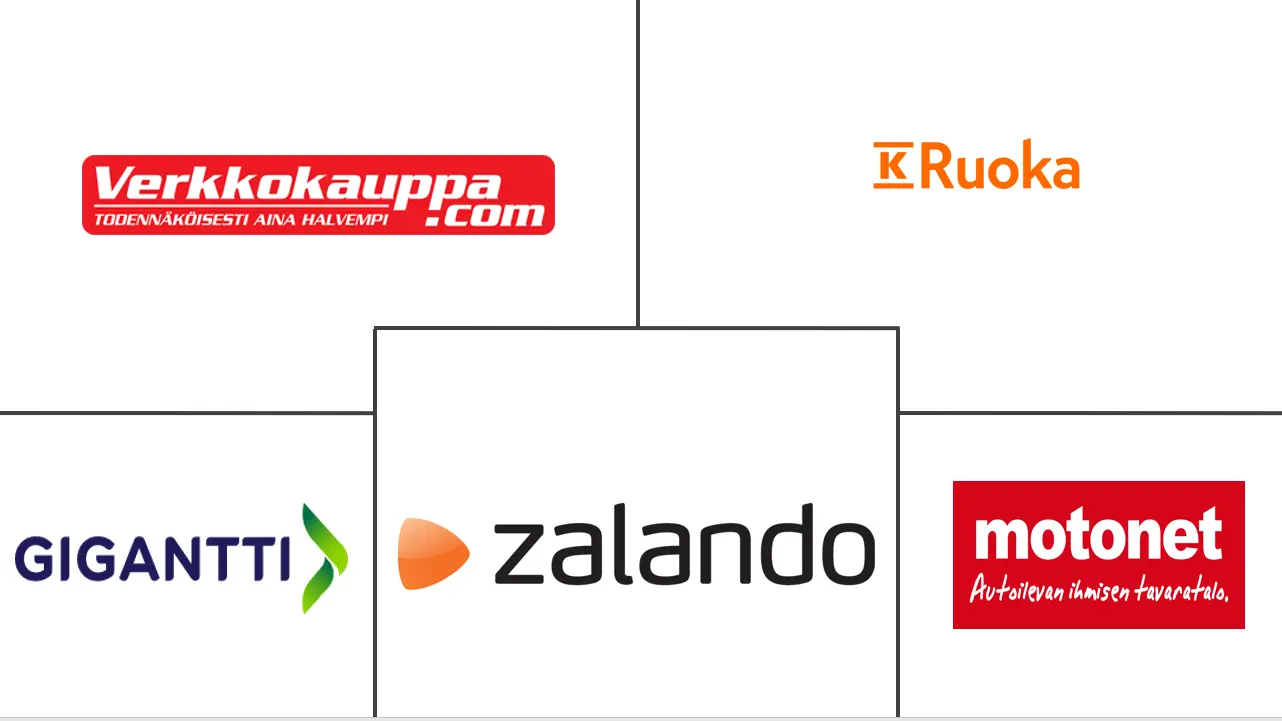
*Disclaimer: Major Players sorted in no particular order |
Finland E Commerce Market Analysis
The Finland e-commerce market is expected to register a CAGR of 7.4% during the period 2022-2027. The Finland e-commerce market is primarily driven by the increasing internet penetration, advanced infrastructure, and an increased number of online shoppers in the country.
- Finland has high internet penetration, with 97% of the population accessing the internet. Finland has also developed a robust e-commerce service provider ecosystem, and e-commerce is widespread and growing, driven mainly by the greater variety of goods. Moreover, lower prices are offered when compared to traditional brick-and-mortar retailers.
- Digital marketing in Finland has increased in the past few years. More service providers in the region, including traditional marketing companies, such as Suomen Digimarkkinointi and Avidly, have risen to help companies provide their services. Facebook and Google have already established strong positions in Finland, accounting for approximately half of digital marketing in Finland. E-commerce market players are opting for digital marketing to boost their regional presence.
- Moreover, most Finnish customers use online banking as their preferred payment method. Still, the region has been witnessing growth in mobile commerce over the past few years, which is further expected to boost the development of the market. Furthermore, rising household income and increasing employment further paved the way for e-commerce in the region.
- According to new European rules, consumers have a product guarantee of up to 2 years. When the product breaks, retailers cannot ask for a usage fee. But longer guarantee periods in Finland can cause problems for online merchants. The European Union (EU) rules are supposed to harmonize e-commerce and consumer guarantees across Europe. But because of differentiating guarantee periods in Finland, the rules can potentially harm retailers.
- During the COVID-19 pandemic, the most evident change has been the growth of online shopping compared to the pre-pandemic years. More people were going online, not just those shopping online making more purchases, but more and more customer sentiment towards shopping online. However, the infrastructure of grocery delivery struggled, as merchants were not fully prepared, even with click-and-collect.
Finland E Commerce Market Trends
This section covers the major market trends shaping the Finland E-commerce Market according to our research experts:
Growth Potential in Mobile Commerce
- The growing use of smartphones and rising consumer demand for convenient payments have fueled growth in mobile payments. M-payments, including mobile wallets and carrier billing, are growing rapidly among Finnish consumers.
- The growth of e-commerce in Finland is facilitated by the development of information technology, including online and m-payment services. Consumers in Finland mostly use credit transfers to pay for online purchases. And while the shares of payment cards and cash on delivery decreased, digital wallets, mobile wallets, carrier billing, and direct debit increased their shares during the last couple of years, as consumers increasingly began to use phones to make payments for online shopping.
- Mobile commerce represents an innovative way to build customer value and a new, unique distribution channel for digital products and services. Mobility translates to new opportunities, and many players and consumers are rapidly adopting m-commerce to create choice and value consecutively. Mobility offers much more than convenience as it may revolutionize how companies work, buy, sell and collaborate.
- Moreover, the benefits offered by mobile commerce, such as in-app purchasing (such as buying clothing items via an e-commerce app), Mobile banking, Virtual marketplace apps, and Digital wallets, are attracting consumers to the region for mobile commerce.
- Mobile commerce is preferred by the younger generation of Finland's population, and smartphones are the primary device for online shopping among millennials. Furthermore, rising smartphone penetration is also boosting the growth of mobile commerce in the region.
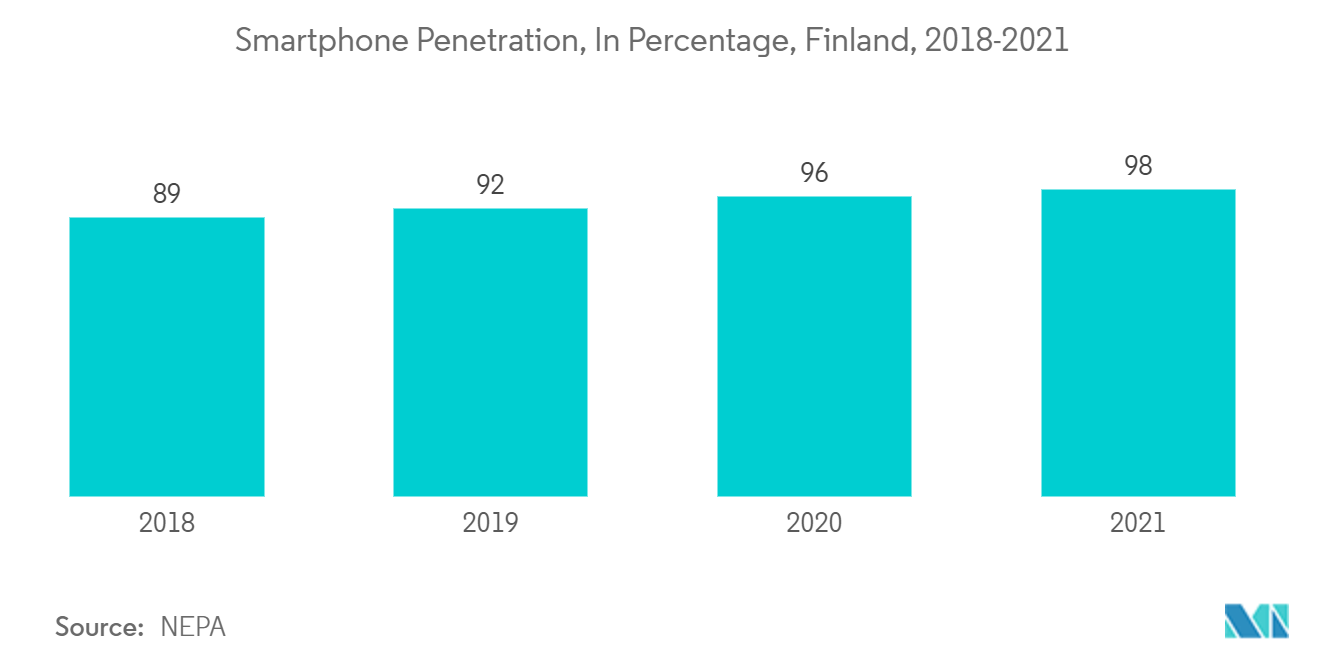
The Fashion and Apparel Segment Accounted for the Significant Market Share
- One of the leading trends in Finland's e-commerce market is the direct integration of shopping functionality into the content display on social media enabling high-speed, "inspire and sell" customer conversion (such as Instagram and Facebook Checkout). The consumer is shifting from desktop to mobile, and improving the mobile browsing and checkout experience is crucial.
- Growing household consumption and fashion trends fuel fashion segment growth in the region. Many major market players opt for digital advertising via Facebook and Instagram to attract customers. Furthermore, the ongoing industrial transformation will enable new business in Finland. The country's strengths in production are related to the sustainable raw material base, which is increasing the demand for clothing and footwear in the market.
- The Finnish textile industry has recently attracted international attention because of the new textile fibers. Sustainable production is increasingly becoming important in customers' expectations and choices. The changing EU rules and regulations also accelerate the bio-based and recyclable raw materials and textiles market. Finland also has large amounts of expertise in the technologies needed to enable the sustainable production of fibers and fabrics. This is expected to grow the clothing and footwear sales in Finland's e-commerce market.
- Furthermore, the increasing number of e-shoppers in the region is also propelling the growth of the fashion e-commerce market. As per EUROSTAT, the percentage of internet users that bought goods or services online in 2016 was 72% and increased to 79% in 2021. Furthermore, Black Friday sales offered by the top market players in the region also generate demand for the fashion segment in the e-commerce market.
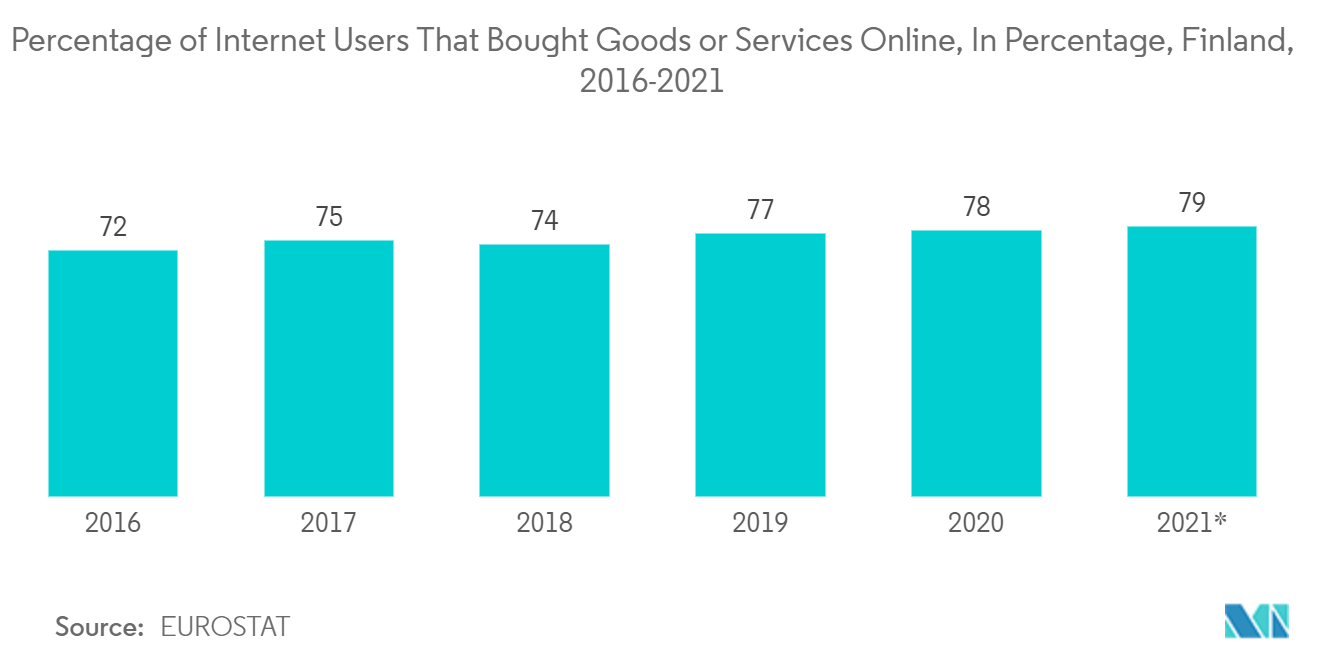
Finland E Commerce Industry Overview
Finland's e-commerce market is moderately fragmented in nature. Key major players include Verkkokauppa.com and Zalando.fi, Gigantti Oy, and Motonet Oy. These major players actively participate in partnerships and product innovations to gain regional market share.
- March 2022 - Finnish social shopping app Blidz raised EUR 6 million in seed funding. The company will use the funding to accelerate its growth in Western markets. Additionally, the funding will expand the product suite and supply chain. Currently, the shopping app has a product range going from consumer electronics, fashion, groceries, home and gardening products, and virtual items. The company raised EUR 6 million in Seed funding to grow the product suite and supply chain.
- February 2022 - Finnish e-commerce company Verkkokauppa.com announced its first acquisition with the purchase of online retail store E-Ville. Based in Finland, e-Ville serves customers in Finland and the Nordic countries. The platform offers a selection of mobile phones, bicycles, leisure equipment, electronics, and other home products.
Finland E Commerce Market Leaders
-
Verkkokauppa.com
-
Zalando.fi
-
Gigantti Oy
-
K-Ruoka
-
Motonet Oy
*Disclaimer: Major Players sorted in no particular order
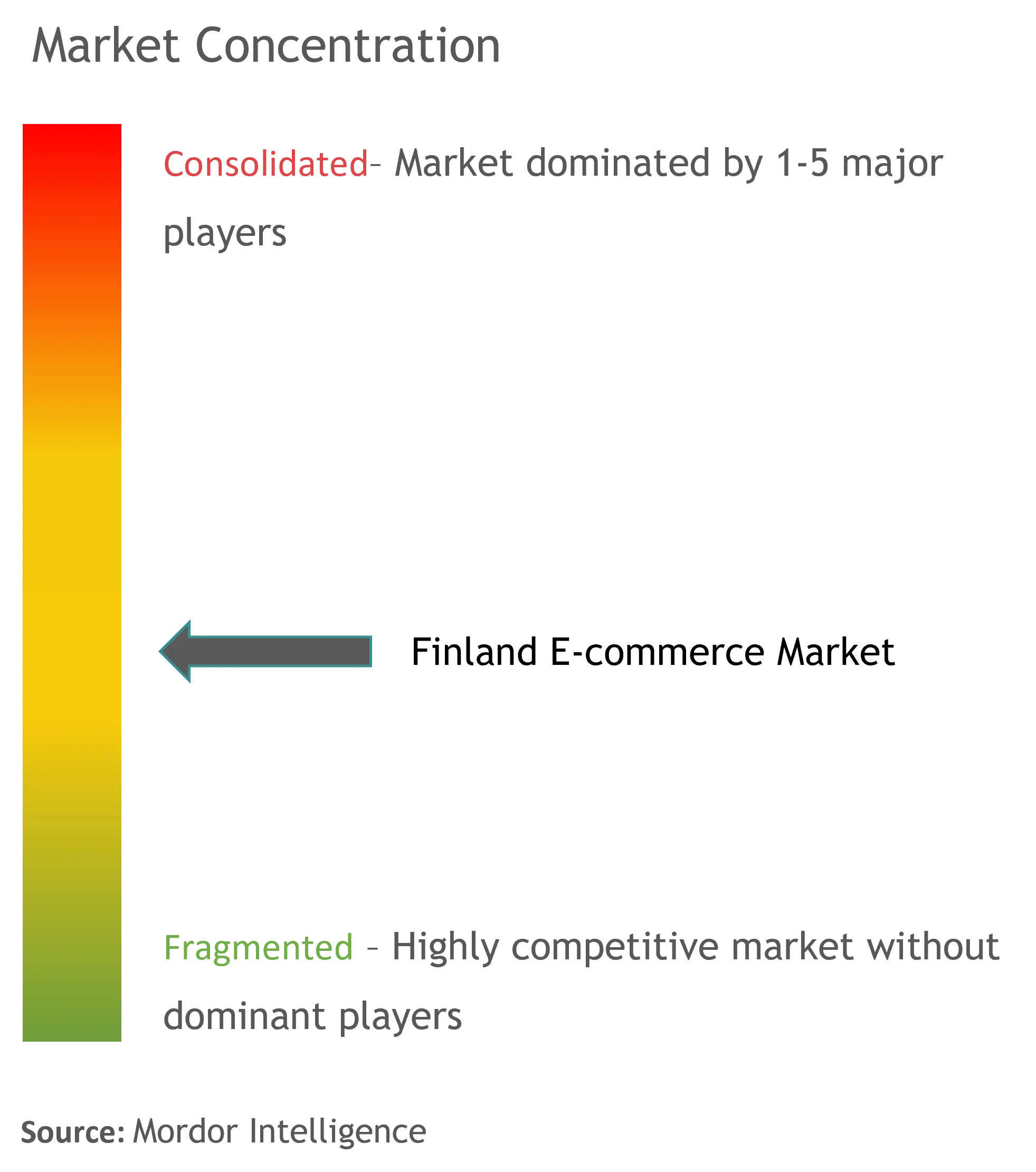
Finland E Commerce Market News
- April 2022 - Upsy company, the Finnish e-commerce product helping smaller businesses compete, has just picked up EUR 1.2 million. The fresh capital will be used for product development, the opening of new markets, and the further development of the product's AI and neural network capabilities to lead the shopping assistant category on a global level.
- February 2022 - Postal operator Posti announced investing more than USD 113 million in a new logistics center in Finland. It is said that the new logistics center will start operations around 2025 and form part of the company's overall growth strategy.
Finland E Commerce Market Report - Table of Contents
1. INTRODUCTION
- 1.1 Study Assumptions and Market Defination
- 1.2 Scope of the Study
2. RESEARCH METHODOLOGY
3. EXECUTIVE SUMMARY
4. MARKET INSIGHTS
- 4.1 Market Overview
-
4.2 Industry Attractiveness - Porter's Five Forces Analysis
- 4.2.1 Bargaining Power of Suppliers
- 4.2.2 Bargaining Power of Buyers/Consumers
- 4.2.3 Threat of New Entrants
- 4.2.4 Threat of Substitute Products
- 4.2.5 Intensity of Competitive Rivalry
- 4.3 Key Market Trends and Share of E-commerce of Total Retail Sector
- 4.4 Impact of COVID-19 on the E-commerce Sales
5. MARKET DYNAMICS
-
5.1 Market Drivers
- 5.1.1 Growth Potential of Mobile Commerce
- 5.1.2 Rising Employment and Growing Gross Disposable Income
-
5.2 Market Challenges
- 5.2.1 Rules and Regulations for Longer Guarantee Periods
- 5.3 Analysis of Key Demographic Trends and Patterns Related to E-commerce Industry in Finland (Coverage to Include Population, Internet Penetration, E-commerce Penetration, Age & Income etc.)
- 5.4 Analysis of the Key Modes of Transaction in the E-commerce Industry in Finland (Coverage to Include Prevalent Modes of Payment Such as Cash, Card, Bank Transfer, Wallets, etc.)
- 5.5 Analysis of Cross-Border E-commerce Industry in Finland (Current Market Value of Cross-border & Key Trends)
- 5.6 Current Positioning of Finland in the E-commerce Industry in Europe
6. MARKET SEGMENTATION
-
6.1 By B2C E-commerce
- 6.1.1 Market Size (GMV) for the Period of 2017-2027
- 6.1.2 Market Segmentation - by Application
- 6.1.2.1 Beauty and Personal Care
- 6.1.2.2 Consumer Electronics
- 6.1.2.3 Fashion and Apparel
- 6.1.2.4 Food and Beverages
- 6.1.2.5 Furniture and Home
- 6.1.2.6 Others (Toys, DIY, Media, etc.)
-
6.2 By B2B E-commerce
- 6.2.1 Market Size for the Period of 2017-2027
7. COMPETITIVE LANDSCAPE
-
7.1 Company Profiles
- 7.1.1 Zalando.fi
- 7.1.2 Verkkokauppa.com
- 7.1.3 K-Ruoka
- 7.1.4 Gigantti Oy
- 7.1.5 Motonet Oy
- 7.1.6 H&M
- 7.1.7 Power.fi
- 7.1.8 Apple Inc.
- 7.1.9 Etuovi.com
- 7.1.10 Tori.fi
- *List Not Exhaustive
8. Investment Analysis
9. Future Outlook of the Market
** Subject To AvailablityFinland E Commerce Industry Segmentation
E-commerce, also known as electronic commerce, refers to all online activity involving buying and selling goods and services. E-commerce offers convenience, borderless transactions, and scalability, among other benefits.
The Finland E-commerce Market is Segmented into B2C E-commerce (Beauty and Personal Care, Consumer Electronics, Fashion and Apparel, Food and Beverage, Furniture and Home), and B2B E-commerce.
| By B2C E-commerce | Market Size (GMV) for the Period of 2017-2027 | |
| Market Segmentation - by Application | Beauty and Personal Care | |
| Consumer Electronics | ||
| Fashion and Apparel | ||
| Food and Beverages | ||
| Furniture and Home | ||
| Others (Toys, DIY, Media, etc.) | ||
| By B2B E-commerce | Market Size for the Period of 2017-2027 |
Finland E Commerce Market Research FAQs
What is the current Finland E-commerce Market size?
The Finland E-commerce Market is projected to register a CAGR of 7.40% during the forecast period (2024-2029)
Who are the key players in Finland E-commerce Market?
Verkkokauppa.com, Zalando.fi, Gigantti Oy, K-Ruoka and Motonet Oy are the major companies operating in the Finland E-commerce Market.
What years does this Finland E-commerce Market cover?
The report covers the Finland E-commerce Market historical market size for years: 2019, 2020, 2021, 2022 and 2023. The report also forecasts the Finland E-commerce Market size for years: 2024, 2025, 2026, 2027, 2028 and 2029.
Ecommerce in Finland Industry Report
Statistics for the 2024 Ecommerce in Finland market share, size and revenue growth rate, created by Mordor Intelligence™ Industry Reports. Ecommerce in Finland analysis includes a market forecast outlook 2029 and historical overview. Get a sample of this industry analysis as a free report PDF download.



